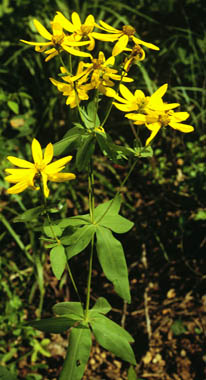Coreopsis major W.
Author: Kimber Collins General Ecology Major
University of Georgia Student
Athens, Georgia

Photograph taken by W.H. Duncan in a open deciduous woods in SE Athens Georgia.
Click on the picture to get a higher definition Picture.
Table of Contents
Back to Genus Page
Back to Family Page
Common Names: Greater Tickseed, Wood Tickseed, Common Tickseed, Whorled-leaf Coreopsis
General Description:
The Coreopsis Major belongs to the Aster or Sunflower Family, and has over 100 species. It grows to the height of two to three feet tall, and has a slender stem. The variety Stellata has a smooth stem while the stem and leaves of the variety Major are hairy (Hutson, Hutson, and Sharp, 1995). It's leaves are two to four inches long and one quarter of an inch to an inch wide. They are opposite, stalkless and are divided into three long, narrow segments giving the appearance of six leaves in a whorl. The flower heads are one to two inches across, with six to ten yellowish rays (Grimm, 1993). "The name Coreopsis translates "like a bug", and refers to the shape and color of the seeds. This is likely how the common name, Tickseed, evolved"(Armitage, 1989).2. GROWTH RATE- moderate to fast (Perry).
3. PESTS AND PROBLEMS- leaf spots, rusts, aphids, plant bugs, beetles (Perry).
4. SEASONAL ACTIVITY-flowers from June to August (Porcher 1995).
5. REPRODUCTION-Click here for information on reproduction.
6. OTHER- Butterflies don't care about the color of the flowers on which they feed, but they do like sun, so the often feed on C. Major since they grow in areas where they can get full sun (Time-Life, 1989).